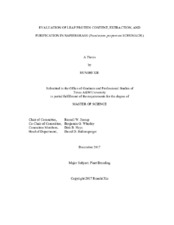| dc.description.abstract | As protein deficiency is still a major health issue in the less developed portion of
the world, novel sources of protein need to be identified. Grasses in the genus
Pennisetum, such as napiergrass, can be a potential alternative protein source. The robust
growth nature of grass provide abundant biomass, as well as enough protein to supply
both livestock and human diets. However, plants are difficult to utilize as protein
sources due to both non-digestible fiber fractions and antiquality factors (phytates,
tannins, etc.). Therefore, feasible approaches are needed to further estimate and purify
the leaf proteins. The objectives of this research are, first, to identify the potential
relationship between leaf proteins and chlorophyll content index (CCI) for developing
indirect tools for leaf protein quantification; and secondly, to further evaluate methods of
leaf protein extraction and purification techniques, including heat coagulation (HC),
mild alkali extraction (AL), and mild alkali extraction with the novel utilization of
activated carbon (ALC). The percentage of crude protein in napiergrass was found to
decrease sequentially at 30, 60, and 90 days of growth in this study. Trends of
decreasing crude protein content between napiergrass parent group and both its selfpollinated
progeny group and its Fv1 hybrid progeny group were also identified. Two
spectroscopic methods were used in this experiment, and both have reported low r^2
values (the highest r^2 = 0.477) for the correlation between crude protein content of
napiergrass and CCI at three harvest dates. Neither heat coagulation nor mild alkali
extraction method improved the extractability of leaf protein. Activated carbon column
treatment effectively removed anti-quality factors (tannins) detected for this experiment.
However, the utilization of activated carbon also caused lower protein yield in the final
purified product. | en |


